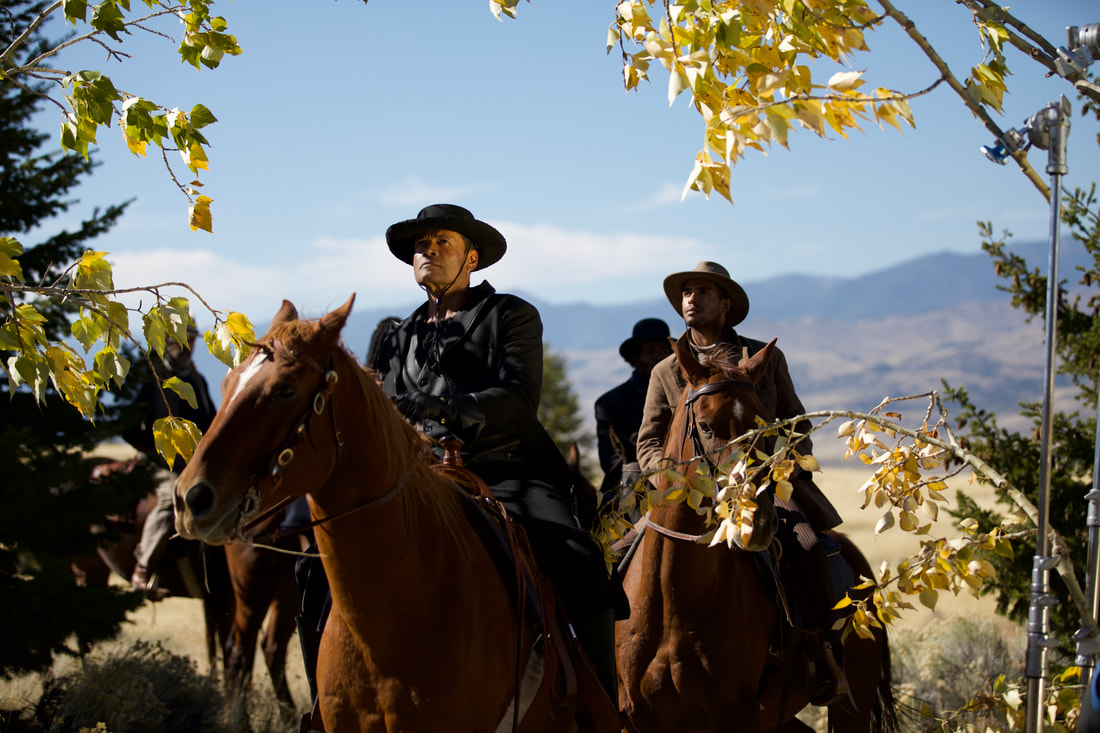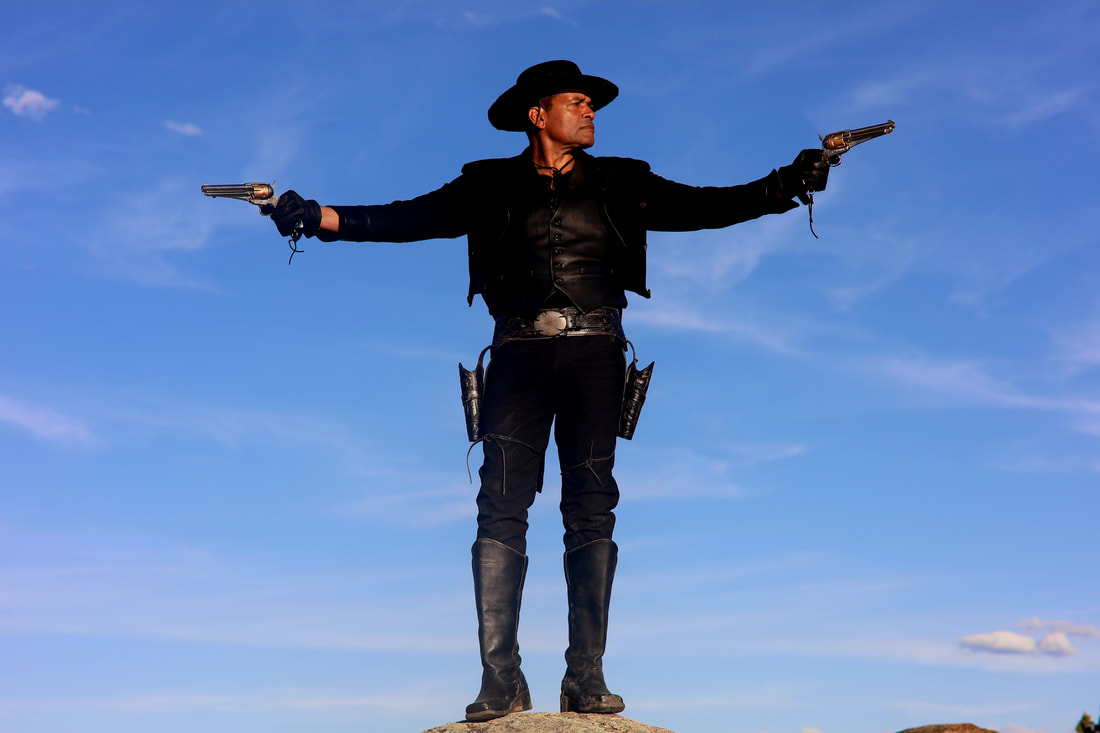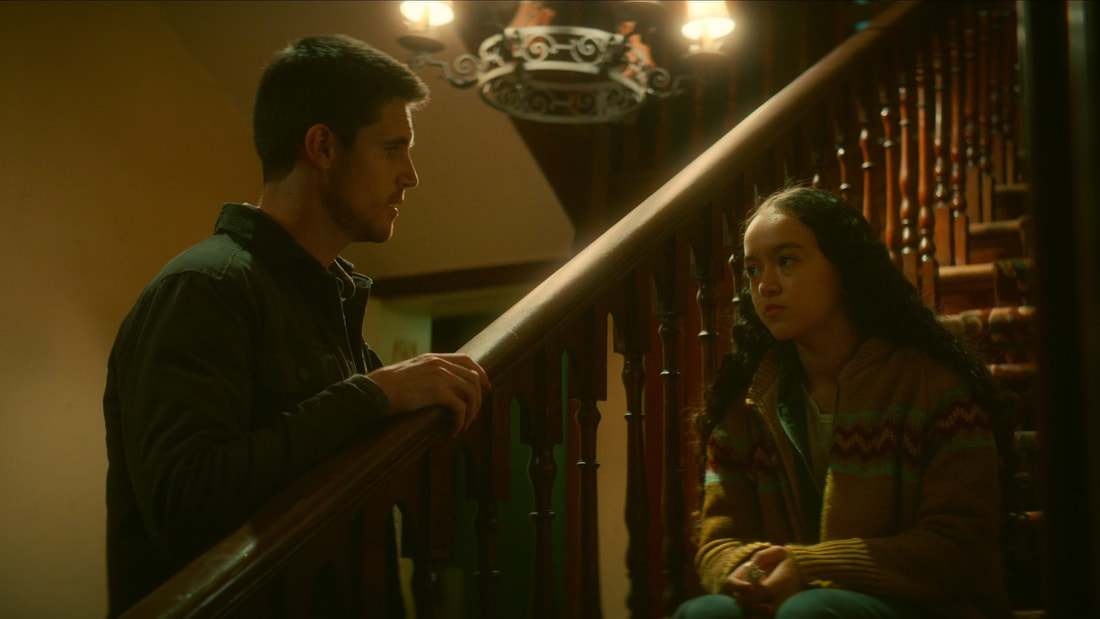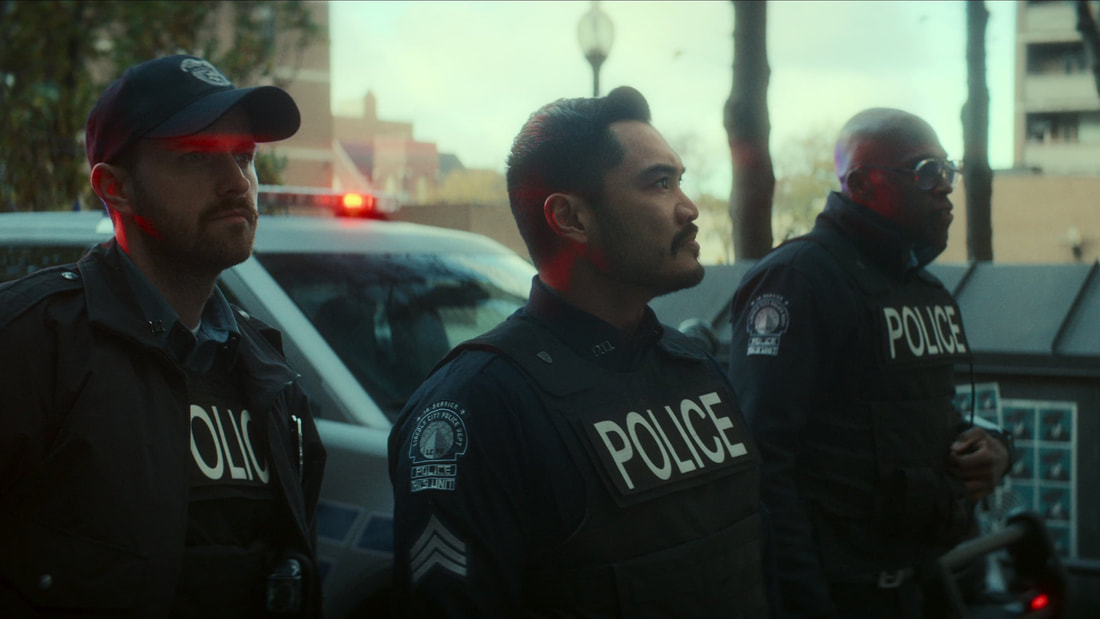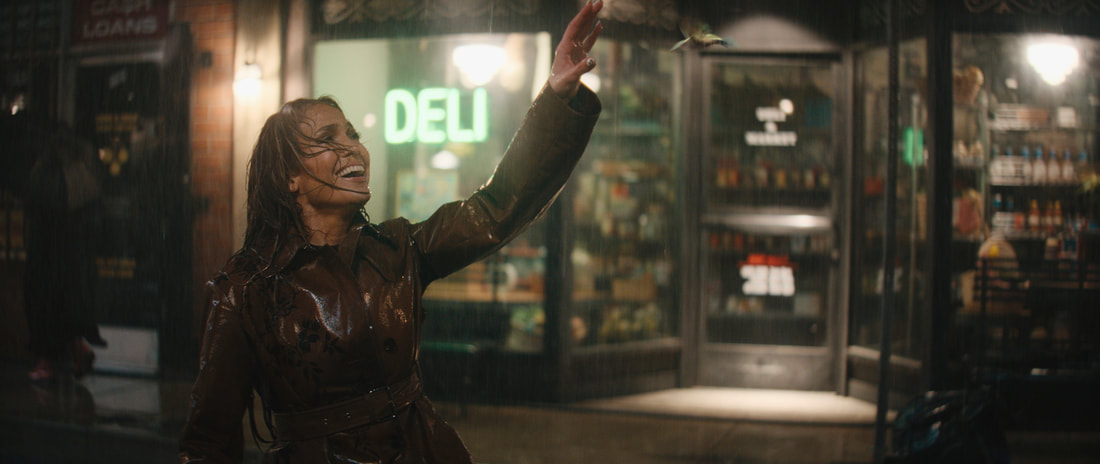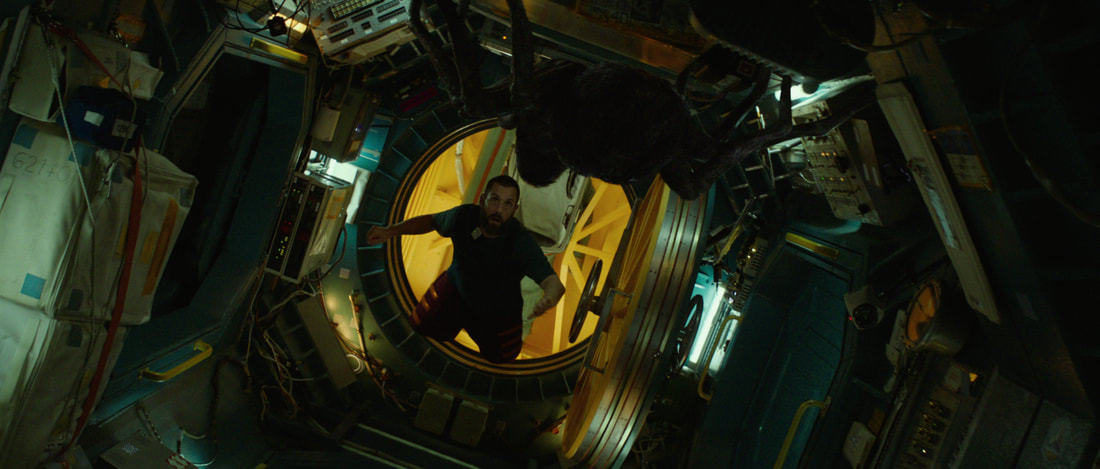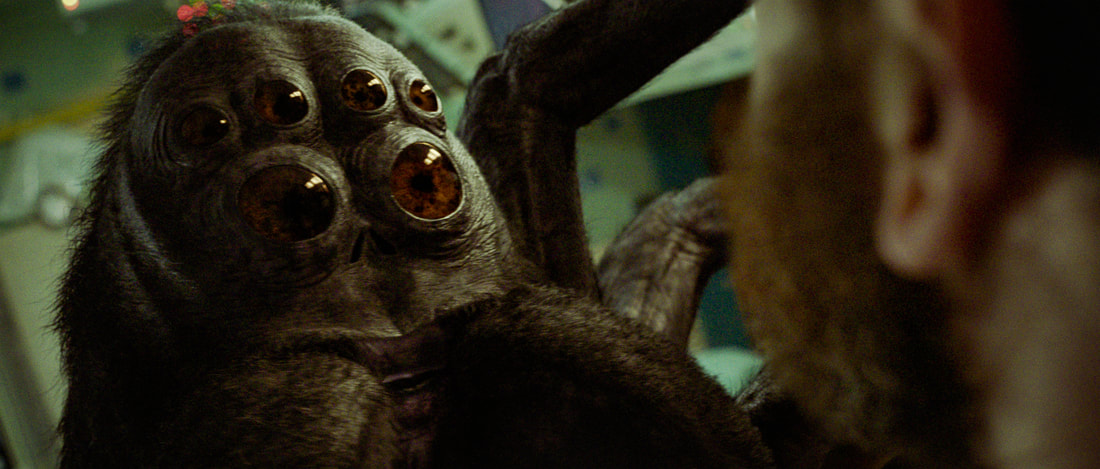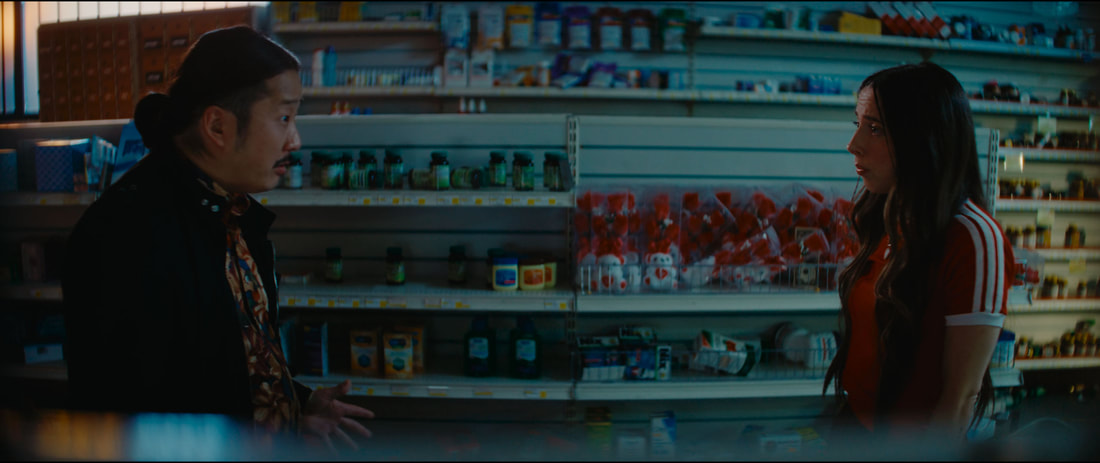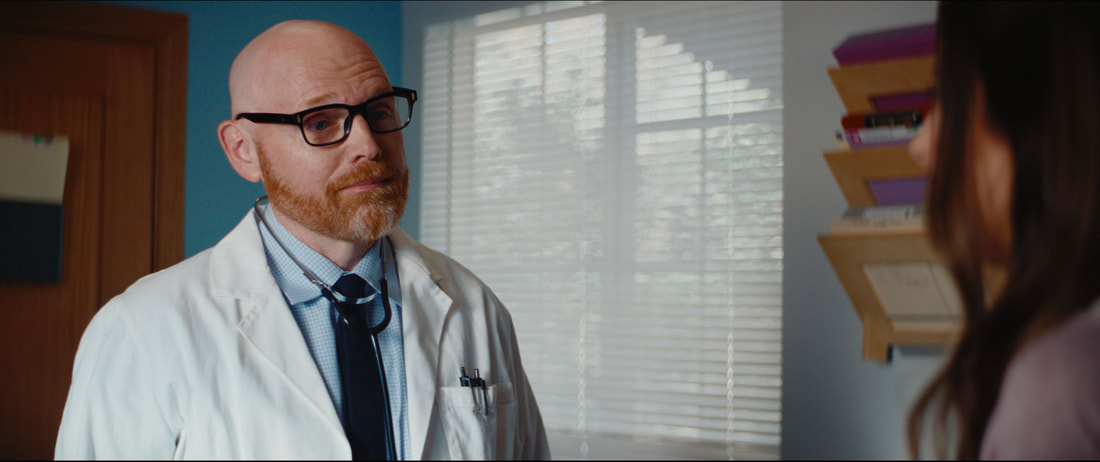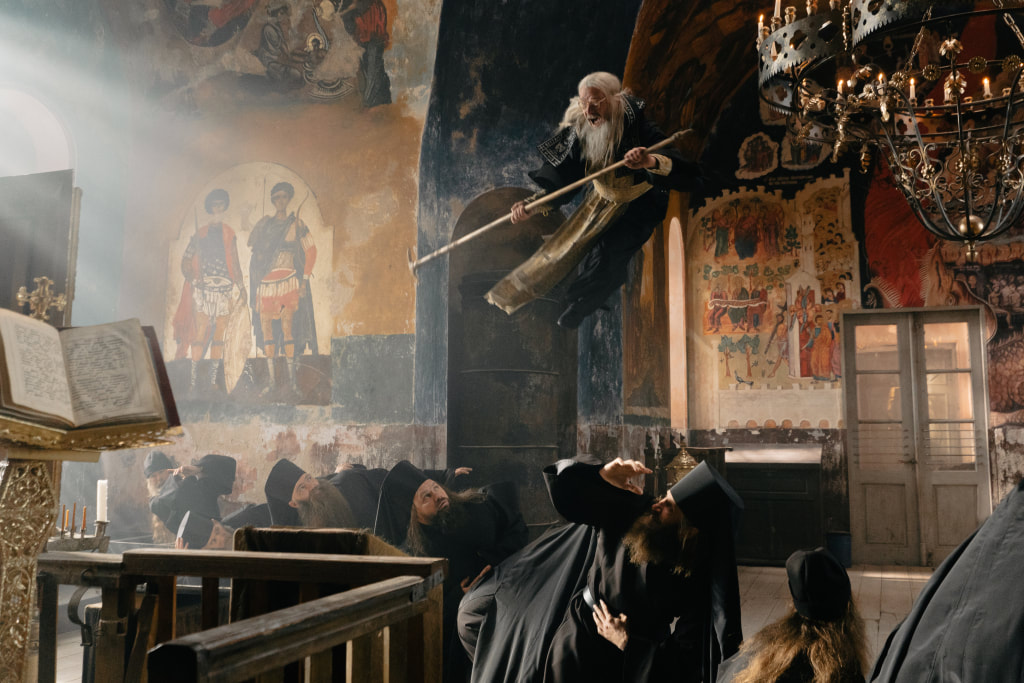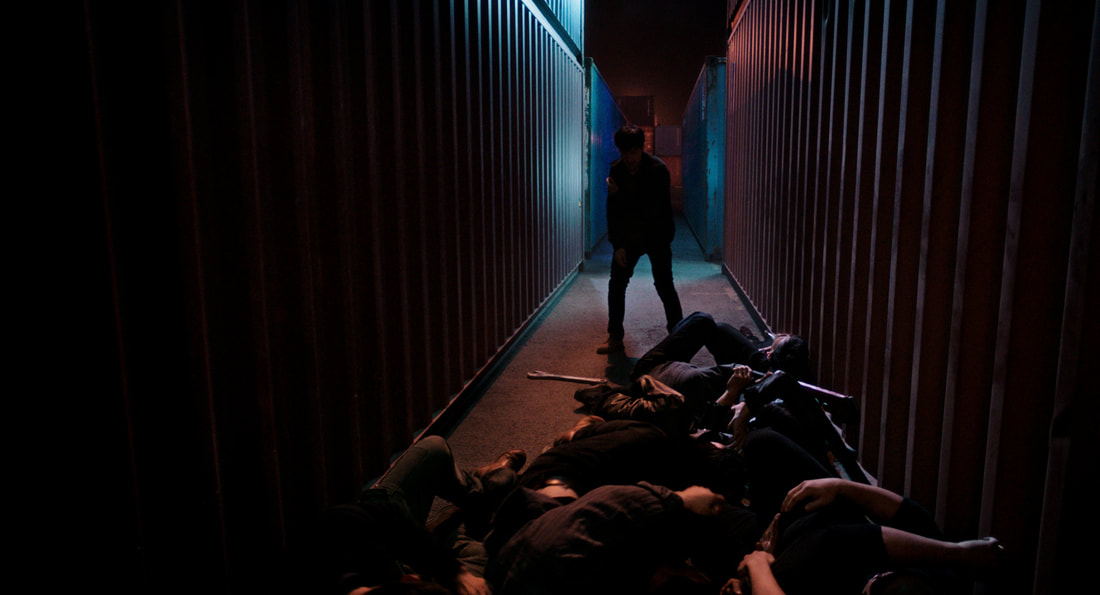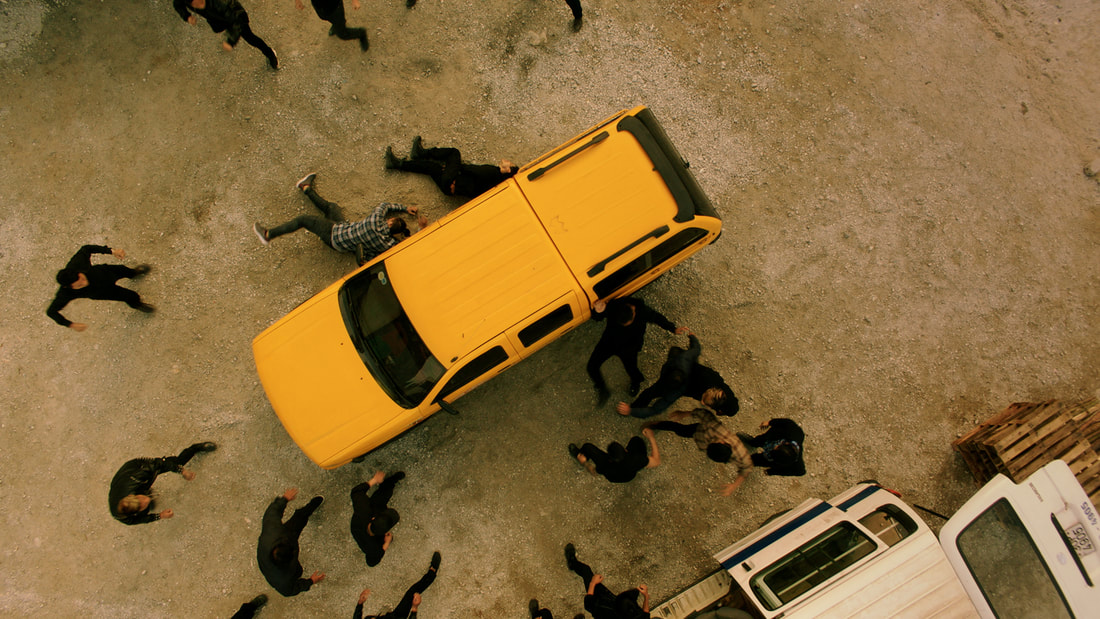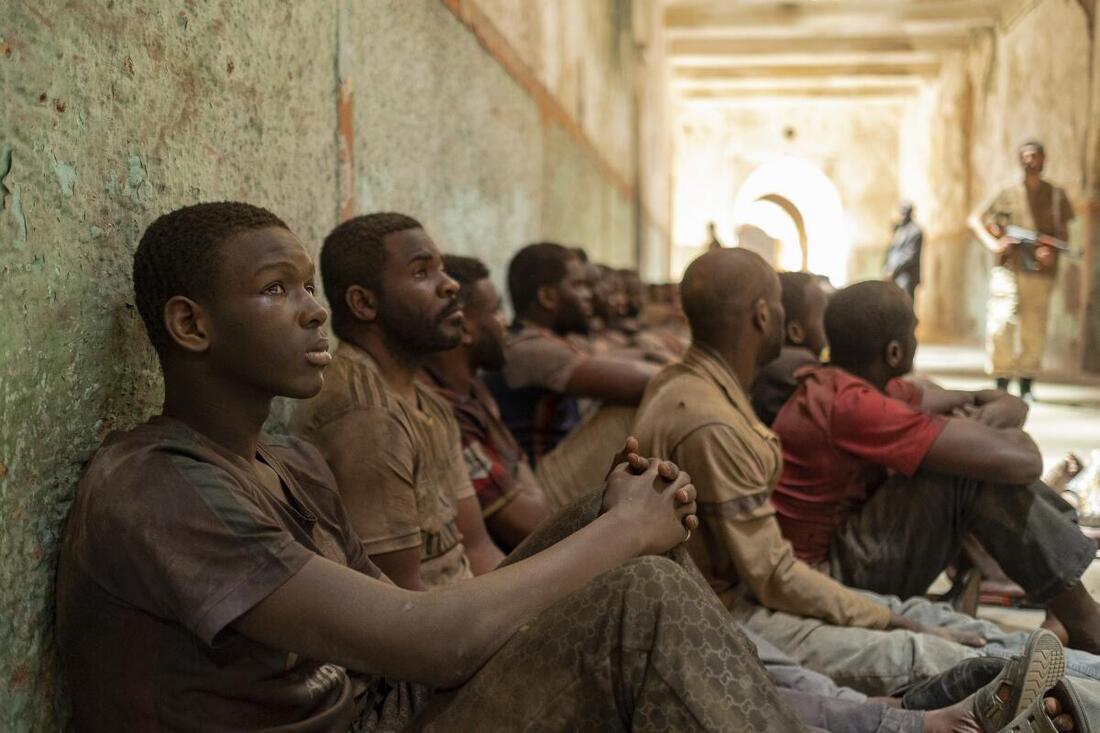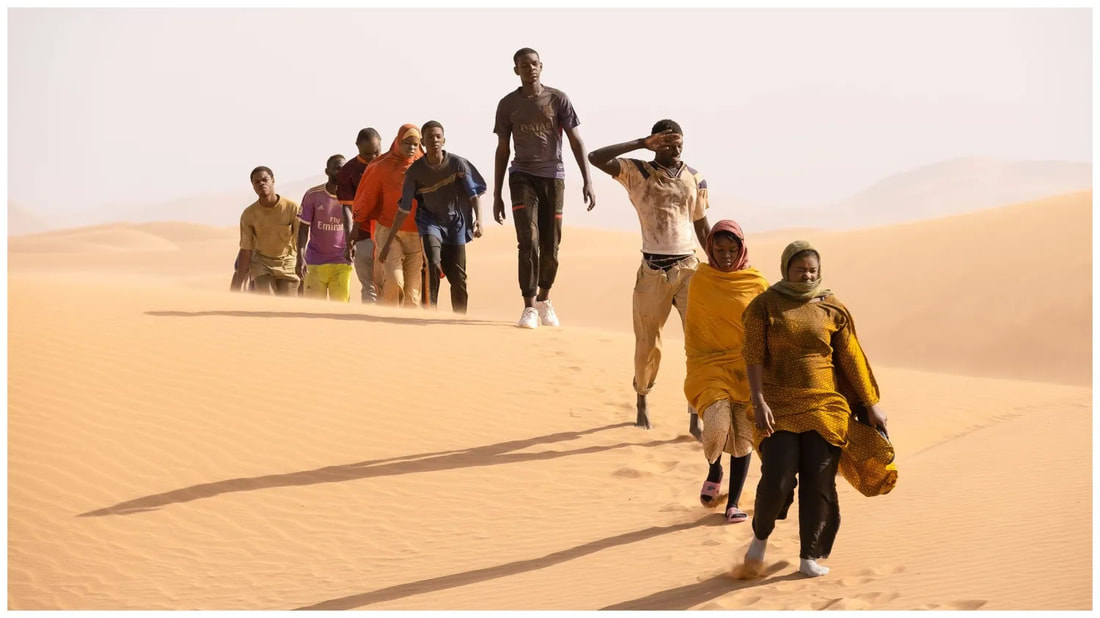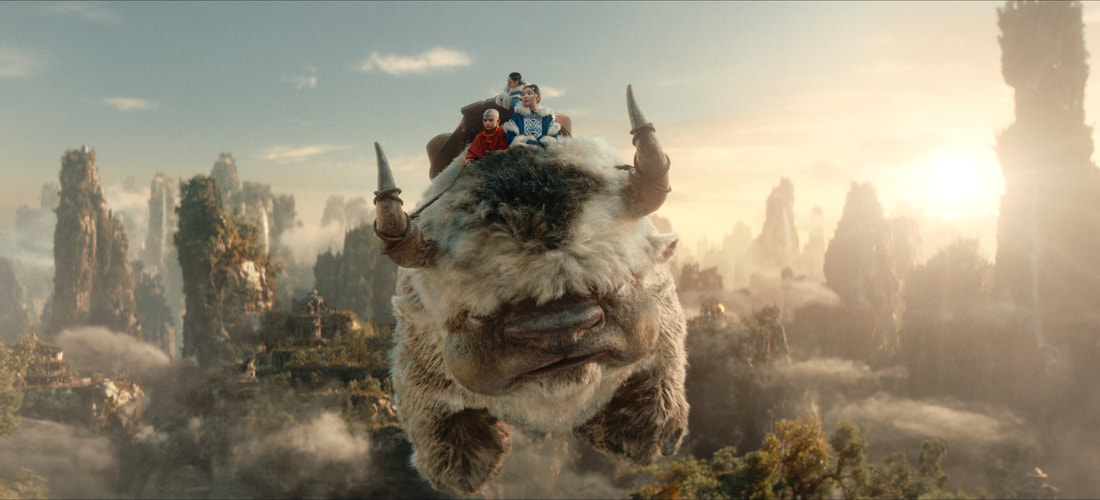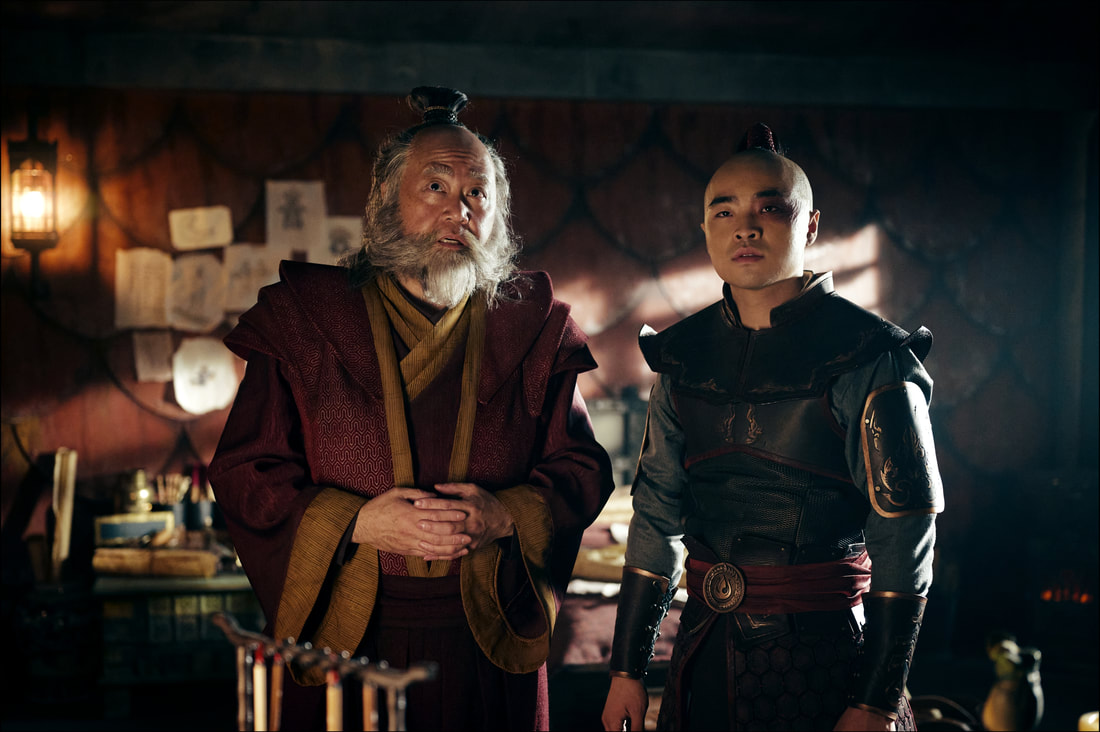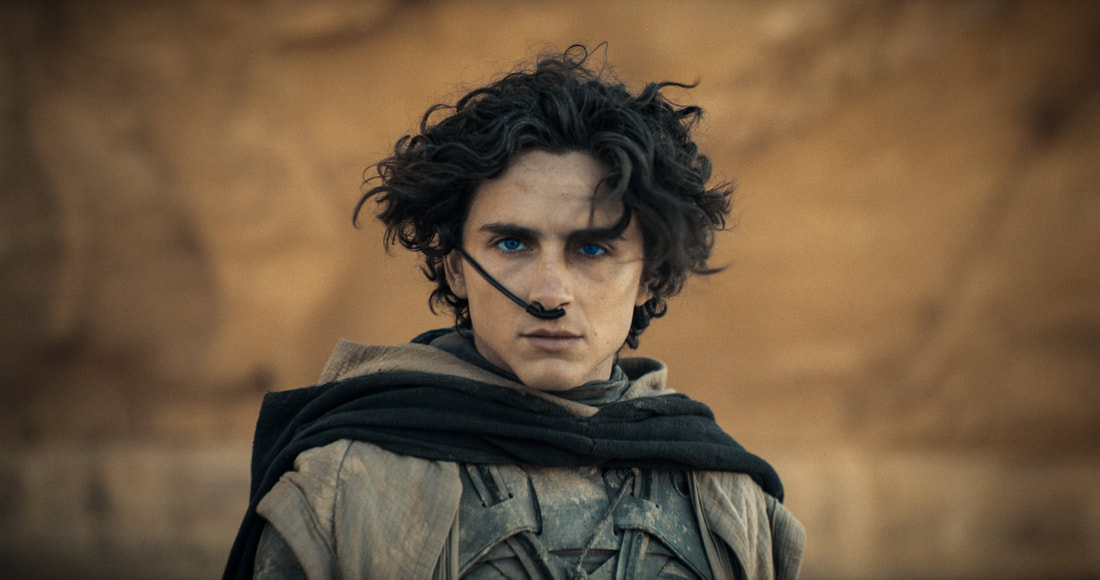|
Review by Sean Boelman
Many modern-day Westerns tend to be bleak and dour, so seeing one that just wants to be fun to watch is refreshing. The latest film from writer/director/star Mario Van Peebles, Outlaw Posse, is a revisionist Western that adheres to most of the conventions of the genre but is consistently entertaining nonetheless.
Outlaw Posse follows a notorious outlaw who returns from hiding to find a hidden cache of gold, only for a dangerous man from his past to be on his tail, kicking off an explosive adventure. Although it doesn’t reinvent the wheel, Mario Van Peebles has made an enjoyable throwback with enough action and quippy one-liners to keep you smiling through its sometimes quotidian story. The most interesting thing about Van Peebles’s latest film is what he does with it thematically. The Western is not a genre known for being particularly progressive — especially regarding race — but Van Peebles takes these cliches and uses them to reclaim the genre. It’s not exactly subtle, but there is some sharp dialogue where Van Peebles’s character satisfyingly lays it onto the racist white guy. Outlaw Posse is a little scrappy and rough around the edges when it comes to the visuals; it doesn't have the same level of polish that some of the studio-backed Westerns have today. But there’s so much passion and love for the genre in every frame that it’s easy to forgive some of its flaws.
The throwback nature of the film also reveals itself in its characters, who are all on the archetypal side. These arcs are all familiar: the straight-laced son of an outlaw who learns his estranged father may not be who he thought he was, the villain who’s seeking revenge against the antihero for a wrong committed against him long ago, and, of course, the band of misfits that makes up the posse.
Still, everyone in the cast seems to be having a blast, lending the film an infectiously fun vibe. William Mapother is the biggest standout, chewing the scenery as any good Western villain should. Even the A-listers, who one would typically expect to be phoning it in for a smaller production like this, give it their all for their few scenes — Whoopi Goldberg, Cam Gigandet, Cedric the Entertainer, and Edward James Olmos among them. There’s also something incredibly lovable about how much of a full-circle moment this film represents for Van Peebles. Though he’s since become prolific himself, Van Peebles got his start working with his father, Melvin Van Peebles. To see Mario sharing the screen with his son, Mandela, is a fun little moment for cinephiles. It also lends itself to the film nicely because they have a natural rapport. Outlaw Posse doesn’t have the most polish or originality, but it’s consistently entertaining nonetheless. A game cast and Mario Van Peebles’s obvious love for the Western genre allow this to overcome its familiar beats to deliver a memorable entry into the genre. Outlaw Posse hits theaters on March 1. Rating: 3/5
0 Comments
Review by Cole Groth Jeff Chan's 2019 thriller Code 8 is an underrated modern science fiction film. After a crowdfunded campaign led to a feature adaptation of his 2016 short film, the film was released to modest reviews. To see it get a sequel five years later is certainly a surprise. It's fun, interesting, and slick. If you haven't seen it and discovered its existence because of Netflix's release of Code 8: Part II, I'd wholeheartedly recommend you watch both that and this film! Picking up a few years after the ending of the first one, Jeff Chan has directed a sequel that feels delightfully updated for modern times and looks a whole lot slicker than before. Both films occur in Lincoln City, Oregon, in the late '90s. In this world, some people are "power-enabled," giving them various superpowers. Society used to make them perform labor for them, but automation eliminated their jobs, forcing them to turn to a life of crime to make ends meet. Picking up after the events of Code 8, Part II sees Connor Reed (Robbie Amell) back to his lowly ways. The LCPD has created a new era of attack robots meant to hunt down every last power-enabled person. After Connor discovers a young girl (Sirena Gulamgaus) on the run from the police, Connor makes it his duty to protect her. Simply put, this is a lot like a technologically-focused version of Logan. It's gritty and intense, playing more as a thriller than the first film did. It feels a little stuck in generic city at points: corrupt cops, crazy chase scenes, and occasionally lazy dialogue. The point is, this isn't pushing many boundaries, but sometimes the comfort zone is the best place for a movie to exist. Like the first film, both Amells are great. Robbie Amell plays the friendly, protective hero perfectly, and Stephen Amell the bad guy gone good. Sirena Gulamgaus is great, alongside Alex Mallari Jr. Unfortunately, Robbie Amell isn't focused on quite as much as he was on the first one. We spend a little too much time on the secondary characters that, at points, the focus slips from what it should be on.
Since the budget was so small for Code 8, it's incredibly impressive how good this movie looks in comparison. The special effects and cinematography are much better than before, with the Netflix budget showing through each scene. It's sleek and exciting, full of this intensity of a filmmaker who can finally afford to live out the true scope of his vision. Jeff Chan has improved on the first film in many ways. It explores new avenues without losing what made the original so good. If Code 8 was an undiscovered gem, I hope that Code 8: Part II will bring it into the limelight. Both films are excellent science fiction flicks, and each stands on its own while forming a thoroughly thought-out story. As far as Netflix's original sci-fi films go, this is one of their best. It provides solid social commentary on the modern police state and is a fun ride. Fans of the first will undoubtedly love this, but it also offers a fresh experience that those unfamiliar with the story can also love. Either way, it's certainly worth a watch. Code 8: Part II releases on Netflix on February 28. Rating: 4/5
Review by Sean Boelman
Jennifer Lopez isn’t exactly known for being humble. While her latest album might make you doubt your presumptions about the artist, the documentary The Greatest Love Story Never Told reinforces every one of them. If you’ve seen the album film This Is Me… Now: A Love Story, there’s very little value to be derived from seeing the documentary. If you haven’t seen it, there’s even less.
This documentary follows musician Jennifer Lopez as she independently produces a new album and film (This Is Me… Now), which becomes her most personal project yet. This documentary is being billed as the “third piece” of Lopez’s passion project, but instead, it feels like an attempt to milk every bit of money she possibly can out of it. If you’re a big fan of Lopez’s newest album and its companion film, The Greatest Love Story Never Told has all the information you could want to know about it. This documentary shows everything, from the ideation of the album through casting, choreography, production, and distribution. It shows maybe too much, in fact. The most entertaining part of the documentary isn’t actually meant to be entertaining — and it’s Ben Affleck’s participation. Affleck clearly does not want to be part of this; he even says so himself. He looks about as happy to be on camera as he does in the meme of him smoking, but he loves his new(-ish) wife, right? So he has to do it to support her… right?
This is perhaps the most damning thing about The Greatest Love Story Never Told. The album film This Is Me… Now: A Love Story was incredibly vulnerable. It did a surprisingly good job of humanizing the diva. In this documentary, she comes across as callous. Lopez desperately wants to paint herself as an auteur. Every choice she makes is brilliant and right, regardless of who it may hurt. Whether it’s revealing private love letters against Affleck’s wishes or pressuring someone to be in her film despite scheduling conflicts, her divalike behavior has never been more apparent.
Worse yet, the documentary isn’t even particularly well-made. The presentation is incredibly straightforward, consisting of a blend of fly-on-the-wall behind-the-scenes footage and talking head interviews. Most frustrating, though, is the fact that there are several needle drops of popular music that isn’t from Lopez’s new album — including an egregiously obvious use of “Under Pressure.” At a certain point, one will begin to wonder why they are watching an 85-minute documentary about the making of a mid-length album film that’s only around 50 minutes long. Furthermore, what more is there to learn about Lopez from this that she didn’t already convey in her “tell-all” of an artistic project? Somehow, The Greatest Love Story Never Told has the exact opposite effect of what it intended to do — you will walk away feeling less appreciation for This Is Me… Now. It’s a shame because (like it or not) Lopez’s latest project is undeniably ambitious and creative. We don’t need this bland ego trip to tell us that. The Greatest Love Story Never Told streams on Prime Video beginning February 27. Rating: 1.5/5 Review by Jonathan Berk In space, no one can hear you sigh from extreme depression. Well, Adam Sandler puts this idea to the test in director Johan Renck's new film Spaceman. Renck uses the isolation of space and man's desire to explore the unknown to reflect on exactly what we are running from. Jakub (Sandler) is a lone astronaut six months into a mission to explore a mysterious cloud just past Jupiter. His wife, Lenka (Carey Mulligan), has gone radio silent, and he has started to suspect his marriage might not be waiting for him when he returns to Earth. Jakub discovers he's not alone, as a mysterious creature (voiced by Paul Dano) is hiding in the bowels of the ship. The creature helps Jakub work through things as he contemplates if there is still time to fix what he left behind. Sandler's performance in the film is a bit uneven. His dramatic roles in films like Punch-Drunk Love or Uncut Gems have been some of his best, but sometimes he feels like he's phoning it in here. There are moments when he seems to be sleepwalking through the film. While his character is sleep-deprived, it seems that's merely an excuse for some of the deadpan reactions. Fortunately, there are a few moments where we get some of the Sandler charm that makes us hope there is still time to patch things up. Mulligan gets to work off more than a computer-generated creature. She's on Earth and often has to justify her decision to end her marriage. Her situation is even more complex than we initially suspected. Dano brings an ethereal quality to the creature, and while his visage will infinitely disturb some audiences, his performance is undeniable. Not all the exchanges with his character and Jakub actually work, but that isn't the fault of the performances. The film tackles some major existential topics, and sometimes it comes off as cheesy. The purple cloud that sent Jakub on this space odyssey plays heavily on some high-concept ideas that don't all connect. It isn't easy to address some of life's big mysteries, and if you don't subscribe to some philosophies, it may feel silly to try and nail them down.
Much of the film looks good, but sometimes, the visual effects look a little cheap. Some of the little things may feel like they didn't need as much attention. For example, there is an early scene where several objects float around Sandler, and it looks like CG clutter. It isn't enough to wreck the film, but it is noticeable. While not all the film's ideas pay off, and some performances are uneven, Spaceman offers enough to get the audience to reflect on their own life choices and maybe shed a few tears. Other science fiction films broach these topics in more impactful ways, and some are even more grounded than that. Still, these topics are universal and deserve reflection. Why are we always so willing to go into the unknown, seeking what we don't know instead of cherishing what we already have? Spaceman is now in theaters and streams on Netflix on March 1. Rating: 3/5 Review by Adam Donato Esther Povitsky turned down the opportunity to star in a comedy series about her life. That’s not where her opportunities end, as she starred in, wrote, and executive produced Drugstore June. The film is also directed, written, and produced by Nicholaus Goossen, who experienced niche success in the comedic movie Grandma's Boy. It tells the story of a woman stuck in life by her delusions of being a social media influencer. When the pharmacy she works at gets robbed, June makes it her mission to solve the case. With hot comedic talents attached, such as Bobby Lee and Bill Burr, can this modern comedy make an impact? Povitsky’s character begins the movie at the most annoying place possible. This can be draining, but over time, it becomes one of the funnier aspects of the movie. Her character lives in her own world outside of everyday reality, so the other character’s reactions to her are quite comical. While the character works from a comedic perspective, once the plot really starts to kick in, she becomes much less engaging. She goes through an arc that has been done to death, and Drugstore June does little to make itself stand out amongst similar stories. At the end of the day, this movie is a comedy, and the title character supplies consistent laughs throughout. It will be interesting to see what projects Povitsky chooses going forward. Not only does Povitsky’s character become less engaging as the plot thickens, but the story ends up dragging the personality down. The mystery of who robs the pharmacy is not compelling and has an underwhelming payoff. It was a shame to see such little inclusion of Bill Burr’s character, as his scene was one of the funniest in the film. Weirdly enough, Bobby Lee has a very reserved performance. He’s still funny when used, but his character becomes a non-factor for most of the second half.
Drugstore June has a charismatic lead and a solid supporting cast. This movie looks to be a launching pad for Povitsky’s comedy career in film. From the poster alone, this looks like the perfect movie to be dropped on a streaming service. Seldom do movies feel more appropriate for streaming than on the big screen, but this film would thrive off casual at-home watches to find its audience. While the plot doesn’t keep up with the humor, Drugstore June is worth the watch. Drugstore June is now in theaters. Rating: 3/5 Review by Daniel Lima There was a time when the prospect of a silly, lazy pastiche of old kung fu movies that attempted to coast entirely on charm and good vibes was catnip to me, regardless of how well they emulated those films or whether they had a clear voice of their own. Now, the moment I see fake film grain and scratches added in post over digital footage, the blood in my veins freezes up as I prepare for a test of endurance. The Invisible Fight — the latest in this ignoble subgenre — is no better than any of the films that preceded it. In some crucial ways, it is much worse. Ursel Tilk stars as a Russian soldier at a military outpost who is the sole survivor of an attack by high-flying, leather-clad, metalhead warriors. Spurned on by this experience, he becomes a monk at the local Eastern Orthodox monastery with the intention of becoming a “badass at black metal kung fu.” Though he takes to his duties well, jealous brothers, disdainful mothers, and a vexing love interest all vying to pull him away from the spiritual journey he has embarked on. The first scene is the attack by a small group of warriors, blaring Black Sabbath’s music from their boomboxes. It is immediately evident that this film will only superficially borrow the aesthetics of the ones it is aping, amounting to the aforementioned post effects plus the occasional dramatic zoom. It’s not a bad-looking movie, with some interiors displaying genuinely striking lighting, but it is very conventional and in keeping with a modern independent comedy. It fails to either evoke the particular feel of classic martial arts cinema or establish a particular feel of its own. The basic structure is, at first glance, not dissimilar to any number of films about brash young students who labor to join the ranks of Shaolin monks. While they at first join because of their status as legendary martial artists, the tough training instills in them the value and philosophy of the ascetics, to the point that they become genuine converts. They are constantly faced with temptation, but their commitment allows them to persevere. Importantly, however, it is an actual challenge for the heroes of those Chinese (well, typically Hong Kong) films. Tilk’s character is shown to immediately understand all the lessons being impressed upon him, and his many transgressions are all immediately forgiven due to the ease with which he accomplishes his tasks. It could be argued that this allows for the development of the character played by Kaarel Pagga, a pious monk incredibly jealous of Tilk’s success and nonconformity. However, that means most of the runtime is spent with a protagonist who never has to grow or change.
To make matters worse, this movie is nearly two full hours, when most of its inspirations would barely hit an hour and forty minutes. This is the result of a very shaggy narrative, filled with superfluous fluff that never amounts to anything. An encounter with Soviet officials seems like a satiric attack on their policies towards religion, but that is not elaborated on. Many scenes are spent with the women who live in the monastery, but these are ill-defined. There simply isn’t enough here to support such a long runtime, so the film quickly outstays its welcome. One would hope that, if nothing else, the action would capture at least a bit of the spark of people like Lau Kar-Leung, that classic choreography that was so expressive and distinct. That does not happen. These actors are not martial artists or stunt people, nor is the director, and that is made clear by how stiff and immobile all the fight scenes are. There are some inspired beats throughout the action design, mostly involving wirework, but it does have the feel of a high school production where the primary concerns are safety, then comedy, and then excitement at a distant third. This naturally begs the question: “Is it funny?” After all, this movie is more in conversation with the likes of Kung Fu Hustle and Kung Pow: Enter the Fist than Shaolin Temple itself. How does it hold up to the standard of post-modern martial arts comedies? Obviously, this is the most subjective quality of any film. All I can say is that I personally found the film so deeply and abrasively unfunny that it feels like a moral failing on the part of the filmmakers. Like so many other small-scale comedies, director Rainer Sarnet appears so tickled by the idea that he is transposing the classic Shaolin training narrative to his native land and blending it with incongruities like metal music that he forgets to make actual jokes. Most of the comedy is physical, rooted in the spirited performance of Tilk, but he can only go so far when the material is so dusty and hack. Two monks attempting to stop their speeding vehicle give the appearance of performing oral sex; Tilk gets a tour of the abbey in undercranked footage, and he trips on a garden hose; Tilk dumps a bunch of pepper into his food and doesn’t like the taste. That these are some of the comedic highlights of a two-hour film makes most of that runtime agonizing. The most interesting and distinct aspect of The Invisible Fight is the one most frustratingly never fully explored. The Hong Kong films that so mythologized the Shaolin monastery reflected both the spiritual tenets of Chinese martial arts and the contemporary relationship Hong Kong had with mainland China (or, more specifically, the CCP). In setting this film in the Eastern Orthodox Church in the Soviet Union, there are ample opportunities for an exploration of the religion and traditions of the Orthodox Church and the Church’s relationship with a militantly nonreligious government. This thread is not picked up; instead, it simply uses empty platitudes while going through the motions and mimicking the plots of those action classics without recognizing what gave those films that staying power. This, more than anything, is its greatest failure. The Invisible Fight is now in theaters. Rating: 1/5 Review by Daniel Lima With the U.S. releases of both Furies and Bad Blood last year, I wondered if the cinema of Vietnam has been overlooked as a hotbed for no-frills, old-school martial arts action. That may well be the case, but 578 Magnum shows that as high as the highs of that industry are, there are still incredible depths to be plundered. This belongs to a class of movies that could be described as a collection of images projected at a rate of twenty-four individual frames per second to give the impression of movement. Which is to say, it is barely even a movie. The story is nominally about a father out to get revenge on the criminal organization that kidnapped his daughter. He’s a man with a particular set of… well, it’s Taken, just like Bad Blood last year. Curiously, by the time the laughably generic opening credits start rolling, she has already been kidnapped and returned, eliminating the sense of urgency that films of this ilk typically have by default. It’s a baffling decision, yet it’s one of the few even discernibly deliberate choices. Breaking down 578 Magnum is difficult because there are precious few narrative films that have such a lack of coherence and continuity. What characters want at any moment — or are even attempting to do — is never entirely clear. Characters drop in and out of the story seemingly at random. Scenes are haphazardly cut together, making every transition feel jarring. Poor subtitles certainly don’t help clear things up. Every possible deficiency in storytelling pops up, to the point that it feels like the film was shot with nothing more than a general idea of what this kind of revenge tale consists of instead of an actual script.
That said, poor storytelling can be easily excused so long as there are commensurately great set pieces. Sadly, the fights here are almost as bad as those in Taken itself, plagued with the same scattershot editing as the rest of the film. It’s clear these performers are not all trained in stunts or choreography, with many of their movements looking sluggish and lacking any power, often clearly going wide of their target. There are a handful of inspired touches that show someone might have actually cared enough to think through the action design, such as a fight that goes under and inside a car here or a brawl where the hero gets blinded with colorful dyes there. Still, the moments where everything comes together are fleeting. The single most surprising fact about 578 Magnum is that it was, for some unfathomable reason, Vietnam’s submission to the 95th Academy Awards for Best International Film. For such a shoddily made, incomprehensible work to be put for serious awards consideration, the same year that Furies would have also been eligible, calls into question the judgment and soundness of mind of every single person involved in that decision. 578 Magnum is now on VOD. Rating: 1/5 Review by Camden Ferrell Italian director Matteo Garrone follows up his 2019 adaptation of Pinocchio with Io Capitano, a harrowing odyssey through Africa as two Senegalese teenagers try and make their way to Europe. This movie had its premiere at the 2023 Venice Film Festival and has been nominated at this year’s Academy Awards for Best International Film. While one could take issue with a European director making a film about the plight of African migrants, it’s hard to deny that this is an intensely captivating movie that manages to take hold of you due partly to its impressive young lead actors. Seydou and his cousin Moussa are teenagers in Senegal who have aspirations and yearnings for elsewhere. They both have desires to migrate to Europe to achieve success and also help their families out back at home. However, they are not prepared for the dangerous path to Europe. As they leave Senegal, they enter a journey of danger both manmade and natural. This is a story that many African migrants have lived through, and it’s an experience that is important to highlight. While the foundation of the story is quite simple, the writing manages to still make the movie feel wholly unique. It develops its lead characters well and allows the audience to get easily attached to them and invested in their success. The dialogue isn’t the best at times, but this is compensated for by the great performances and tight pacing. The narrative also feels naturally progressive without being predictable. It’s an uncertain journey, and the writing does a great job at reflecting that without losing sight of natural realism in how the plot progresses. As mentioned before, the acting in this movie is impressive, especially for such new and inexperienced actors. Seydou Starr leads the film, and he is able to carry himself through the movie almost flawlessly. He has a delicate and unique control over how his young character slowly gets hardened by this odyssey. There are moments of exhaustion, joy, and pure desperation and pain that he nails perfectly. Moustapha Fall co-stars and while his material isn’t nearly as impressive as Seydou’s, he still does a great job playing off of him and having a natural chemistry on screen. Additionally, Issak Sawadogo has a great supporting role despite it being so brief.
Being directed by a European, a movie like this one was always at risk of feeling out of touch or exploitative, but Garrone goes to lengths to avoid this. He has expressed his understanding of the nuances and implications of himself directing this African story, and he has done his due diligence to work closely with those who have experienced similar things. As a director, he worked with people who migrated out of Africa and faced the same dangers as Seydou and Moussa. This allowed the movie to not be an observation of these challenges from an outsider, but to be a direct reflection of the immigrant experience. The main success of this movie lies in the fact that the audience doesn’t feel like they’re watching this journey but that they’re a part of it. Io Capitano is hard to watch at times, but it’s an emotional journey from start to finish. It’s beautifully shot and directed, and it’s sadly a story that happens all too often. It might not be the best of this year’s international film nominees at the Oscars, but it’s still a worthwhile experience due to its gripping story and phenomenal acting. Io Capitano is in theaters February 23. Rating: 4/5
Review by Sean Boelman
Despite only lasting three years, the cult classic Nickelodeon animated series Avatar: The Last Airbender has a lasting legacy, including being one of the most popular shows of all time on the streaming service Netflix despite not being an original title to the streamer. Although there are certainly some strong elements to Netflix’s new live-action adaptation, it doesn’t focus enough on the things that make it unique for it to stand out in a crowded genre.
As with its source material, the series is set in a world where different tribes control the elements, and a young boy arises as the “Avatar” — the savior of humanity who can bend all four elements and is destined to unite the warring world. Even if you haven’t seen the animated show on which it was based, Avatar: The Last Airbender tells an incredibly familiar story, and it ends up feeling like just another hero’s journey. Interestingly, unlike many adaptations, Avatar: The Last Airbender is working with a similar runtime to its predecessor. This is eight one-hour episodes, while the animated series was 20 twenty-minute episodes — each adding up to eight hours in total. Yet, this live-action adaptation often drags, feeling like it’s going through the motions rather than telling the story earnestly. The show does an incredible job of building the world of ATLA through mostly excellent production design and CGI. The series’s creators clearly wanted to make an adaptation that was faithful in the ways fans would demand. The only thing they don’t quite nail is the tone, which feels a bit too self-serious to work.
That being said, the scale of the series is massive, allowing it to give the audience some truly awesome action sequences. The bending scenes look great, and the spectacular finale that the entire season builds up to is shot in a way that is creative and exhilarating. This show has come far from being a Saturday morning Nickelodeon cartoon.
As far as the cast goes, it’s a bit of a mixed bag. Gordon Cormier is excellent, having all the charm he needs to be Aang, nailing the delicate balance between maturity and youthfulness the role calls for. Kiawentiio and Ian Ousley are fine — not making much of an impression, positive or negative. The weak link is Dallas Liu as Prince Zuko, who seems utterly unable to deliver his lines seriously. In terms of the adults, the show has an incredibly talented cast. Paul Sun-Hyung Lee, Daniel Dae Kim, and Ken Leung all do a great job in their roles, propping up the younger, less experienced actors working alongside them. Fans of the series will also be delighted by James See’s performance. Ultimately, Avatar: The Last Airbender is a passable adaptation. Strong casting for its lead and some very well-done action sequences make it worth watching, even if the writing has glaring weaknesses. But hey, it’s better than the M. Night Shyamalan film — although that’s not a very high bar to surpass. Avatar: The Last Airbender is now streaming on Netflix. All eight episodes reviewed. Rating: 3/5
Review by Sean Boelman
Denis Villeneuve’s Dune was one of the biggest successes of the pandemic era — a sci-fi epic so massive and good that it became a theatrical event despite a simultaneous release on HBO Max. After the success of the first film, Villeneuve was given a bigger budget and more creative free rein, allowing him to make Dune: Part Two into something more grand, more ambitious, and more epic than the last, even if it’s occasionally a bit long-winded.
Dune: Part Two picks up with Paul Atreides on the run with the Fremen, plotting a way to get revenge against the Harkonnen and the Emperor who killed his father. Although Lynch’s 1984 adaptation showed this portion of the story, it crammed it into around 45 minutes — meaning much of the two hour and 46 minute runtime of Villeneuve’s sequel feels completely different. From a purely technical standpoint, Dune: Part Two is a masterpiece. Everything from the production design to the CGI and the cinematography is on point. A few scenes can be difficult to see, but these decisions feel very deliberate. And as with the first movie, the MVP of the below-the-line team is Hans Zimmer, whose booming score is incredible and transports you to the world of Arrakis. Something that was missing from the first film was the political context of Herbert’s writing. While Villeneuve doesn’t explore the anticolonialist elements as much as one might like, he does go into a lot of depth into the property’s religious themes. Frequently, this subplot is just as — if not more interesting — than the bids for power among these various groups.
The one area in which Part Two is a step back from its predecessor is its pacing. There are a handful of really incredible action sequences in this sequel, but all in all, it feels somewhat anticlimactic. The finale, which we have spent two movies building up to, feels particularly unsatisfying — like it is holding back the level of battle we have been teased with.
In the first movie, Timothée Chalamet was the weak link in an otherwise astounding cast. Chalamet has thankfully stepped up his game for this second entry, likely owing to the much meatier role he has here. However, nearly everyone else in the cast has also taken their performances to the next level. Rebecca Ferguson, Dave Bautista, and Josh Brolin all add new layers to their roles. No one quite takes their role to the next level like Javier Bardem, though, whose turn is gripping and humanistic beyond what a movie like this should require. The weakest link here is Zendaya, who is fine but feels like she is trying too hard. In terms of newcomers to the cast, the biggest splash is made by Austin Butler, whose performance is shockingly sinister and unhinged. After his very first line, which has lingering shades of Elvis, he goes fully chameleonic in a horrifyingly effective way. Florence Pugh and Léa Seydoux are solid, but don’t have large enough parts to make much of an impression. Christopher Walken does stick out negatively, though, as it feels like he’s phoning it in most of the time. Dune: Part Two is one of the most impeccably-crafted blockbusters in years from a technical standpoint. It truly is a feat of filmmaking. Even if it is almost held back by some pacing issues, this is such an undeniably epic, visionary achievement that it’s hard not to be astounded by the level of artistry on display. Dune: Part Two hits theaters on March 1. Rating: 4.5/5 |
Archives
July 2024
Authors
All
|
|
|
disappointment media
Dedicated to unique and diverse perspectives on cinema! |

